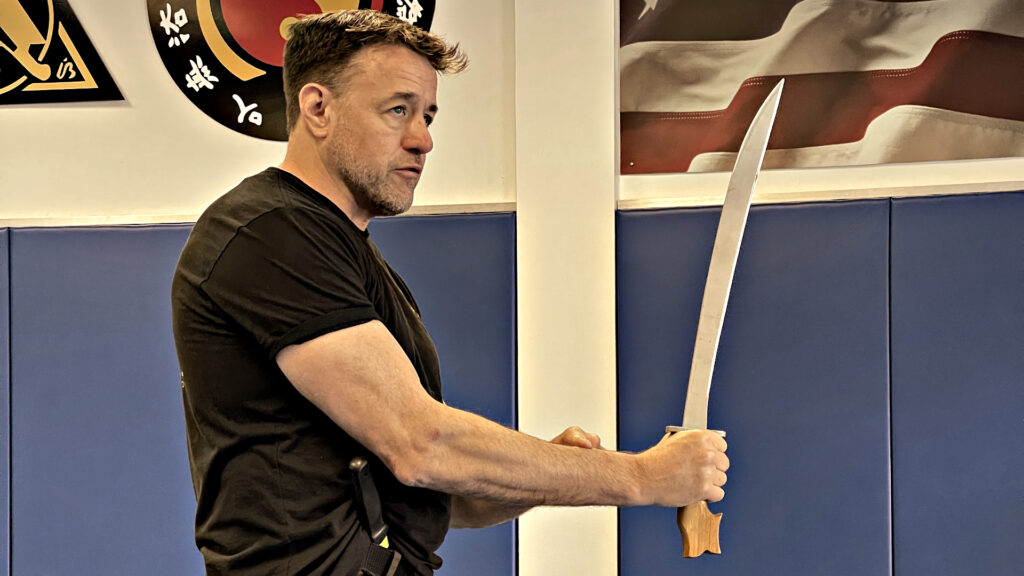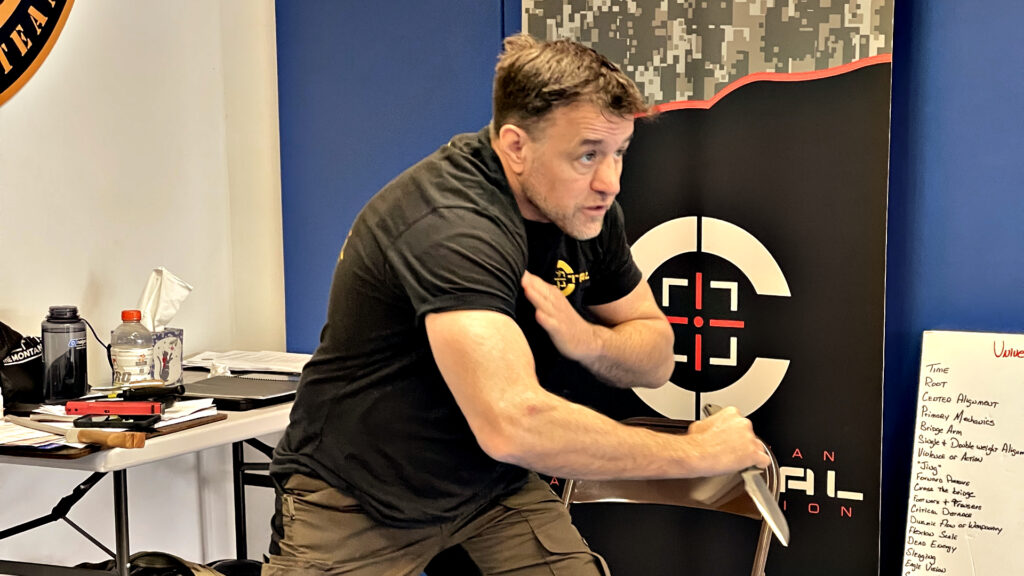
Delving into the basics of utilizing handheld weapons, be they blunt or edged, is not just a necessity but a path to empowerment. Understanding the core principles that make one proficient with any type of handheld weapon, regardless of its nature, is key. Whether it’s an item you’ve intentionally brought along to a situation or something you’ve hastily grabbed in the heat of the moment for self-defense, mastering the foundational aspects of using these weapons can significantly enhance your effectiveness in combat scenarios. This knowledge not only boosts your confidence in potential self-defense situations but also broadens your overall combat skills, making you a more versatile and prepared individual.
Throughout my career spanning over four decades in the Martial Arts community, I’ve explored a wide array of handheld weaponry. It’s quite common to become deeply engrossed in the intricacies of a particular martial art system, to the point where one might lose sight of the ultimate goal of their training. However, as my experience has deepened, I’ve consistently observed the emergence of fundamental basics as the cornerstone of proficiency across various forms of handheld weaponry. These are the simple yet profound principles that apply universally, transcending the specifics of any single weapon type. This realization underscores the importance of mastering these foundational elements, as they equip practitioners with adaptable skills that can be applied effectively regardless of the weapon in hand. Understanding and honing these basics not only enhances one’s versatility and effectiveness in weapon handling but also solidifies a deeper connection to the timeless art of martial weaponry.
Throughout history, the mastery of handheld weaponry has not only been a vital aspect of martial training but also a significant catalyst for physical and mental growth. This traditional practice, deeply rooted in the heritage of countless cultures around the globe, served as a fundamental method to prepare individuals for the challenges of their times, both on and off the battlefield. Engaging with handheld weapons—ranging from swords and spears to clubs and knives—demanded rigorous discipline, sharp focus, and a profound understanding of the body’s movements and capabilities.
This form of training fostered a unique blend of physical prowess and strategic thinking, pushing practitioners to achieve higher physical fitness and agility while simultaneously honing their mental acuity and tactical skills. The study of such weaponry required a deep connection to one’s tools, cultivating a sense of respect and reverence towards the weapon and the art form itself. It was through this dedicated practice that warriors and martial artists developed not just the skills necessary for combat but also virtues such as courage, patience, and perseverance, which were equally applicable in everyday life.
Moreover, the study of handheld weaponry was often intertwined with spiritual and philosophical teachings, offering insights into the nature of conflict, the importance of balance and harmony, and the pursuit of excellence through continuous improvement. In many ways, this comprehensive approach to training with handheld weapons contributed to the individual’s holistic development, integrating physical conditioning with mental and spiritual growth.
As such, the historical significance of handheld weaponry in martial arts goes beyond mere combat preparation; it represents a legacy of fostering comprehensive human development. This enduring tradition continues to influence modern martial arts practices, reminding us of the deep connections between physical discipline, mental fortitude, and the timeless quest for personal and communal harmony.
For my regular readers, you’re familiar with a concept I often discuss called the Combat Blueprint. This principle helps maintain our focus on the broader aspects of confrontations, emphasizing high-percentage fundamentals crucial for success in the key domains of combat. A significant portion of this blueprint is dedicated to the study of weaponry.
Delving into self-defense, it becomes apparent that handheld weapons can significantly tip the scales in your favor against an adversary. This emphasis on weaponry is a distinctive feature of Filipino Martial Arts (FMA). Unlike many other martial arts systems that start with empty-hand techniques and progress to weapons, FMA reverses this order. The primary focus is weapon training, with the philosophy that most physical confrontations begin with a weapon. The transition to empty-hand combat is seen as a secondary skill set, typically employed only if you find yourself disarmed. This approach underscores the belief in the importance of weapons in combat situations, highlighting the strategic advantage they provide in self-defense scenarios.
Personally, my approach to self-defense is heavily rooted in strategic thinking, a perspective that isn’t always prevalent in Martial Arts Academies. Often, these institutions prioritize empty-hand techniques before introducing weapons training. However, I’m not advocating for constant armed readiness with a knife in hand. Rather, my belief is that with adequate training, virtually any item at one’s disposal can be transformed into an effective tool for defense, serving as a crucial equalizer in a threatening scenario. This principle is a key reason why the study of weaponry holds such significance in our curriculum, both in the Academy and within the C-Tac® Program. It’s not just about weapon training; it’s about cultivating the ability to think and adapt strategically in any situation, using whatever resources are available to ensure safety and security. This focus on adaptability and strategic resourcefulness is what we strive to instill in our students, marking a distinct and vital component of our self-defense education.

In the C-Tac® Program Combat Blueprint, the foundational areas of focus are identified as primal environments. We use this terminology to underscore the innate nature of these combat scenarios; these environments leverage instinctive responses that are hardwired into the human nervous system. Intriguingly, the skills and strategies pertinent to these areas can be activated without formal training. In fact, these concepts are so deeply embedded in our physiology and psychology that, when faced with a situation of intense violence or stress, individuals—regardless of their training background—are likely to employ tactics from these primal environments instinctively.
The primal environments encompass:
- Firearms: The use and defensive strategies against firearms tap into our survival instincts, emphasizing the importance of distance, cover, and the decision-making process between fight and flight.
- Edged & Blunt Weaponry: This involves understanding the offensive and defensive dynamics of using knives, sticks, and other handheld objects. It’s about recognizing that objects, when wielded with intent, become extensions of the body’s natural fighting instincts.
- Striking: The primal urge to use one’s body to hit or repel an attacker encompasses a range of techniques, from basic punches and kicks to more complex combinations, all rooted in the instinctive fight response.
- Pummeling: Engaging in close-quarters combat, maneuvering for control, and attempting to dominate an opponent through standing grappling techniques are intuitive responses to being near a threat.
- Ground Fighting: When combatants find themselves on the ground, the instinctive drive to protect oneself and gain the upper hand becomes paramount. Ground fighting strategies are foundational, tapping into the primal need to resist, escape, or subdue.
These primal environments represent the spectrum of human combat response, highlighting the universality of specific tactics and strategies across different situations. By understanding and refining these automatic responses, our training aims to enhance the natural abilities already present within each individual, ensuring they’re better prepared to handle violent encounters with or without extensive formal training. This approach democratizes self-defense, making it accessible and relevant to everyone, regardless of their experience level in martial arts.
The Combat Blueprint offers significant value by providing a structured framework to assess whether your training encompasses the entirety of potential scenarios you might face in a violent encounter. By evaluating your skills across the defined environments within the blueprint, you can identify areas where your training may be lacking. If you discover a gap in your capabilities, this insight allows you to actively pursue further education and training to bridge this gap, enhancing your preparedness for a wider range of situations.
Many martial arts systems tend to concentrate on a single aspect of combat, leading some practitioners to dedicate years, if not decades, to mastering just that one area. While deep expertise in one field can be advantageous, it may also pose limitations during an actual conflict, especially if the situation demands skills outside your area of specialization. Being thrust into unfamiliar territory can leave you vulnerable and at a disadvantage.
Within C-Tac®, we leverage the Combat Blueprint as a guiding tool to ensure our training is comprehensive, covering the full spectrum of violent encounters one might face. This holistic approach guarantees that our students are not only proficient in one aspect of self-defense but are well-rounded, adaptable, and prepared for any situation. By embracing this method, we aim to cultivate individuals who are equipped with the knowledge and skills to navigate and survive the complexities of real-world violence. I aim to develop a greater number of people equipped with the resilience and leadership skills required to tackle challenges directly, especially during critical moments. My vision is for a world where a larger community is prepared and eager to confront the growing challenges.
Shift Your Perspective, Take the Action, Transform Your World.
~ Sifu Alan
The Warriors Path Podcast With Sifu Alan Baker
Civilian Tactical Training Association Instructors Program

Alan Baker is celebrated for his exceptional skill in creating customized Defensive Tactics Programs and his prowess in high-performance coaching. Tailoring his expertise to meet the needs of law enforcement agencies, military groups, and security companies, Alan crafts training curriculums that are grounded in practical techniques, adaptability to real-life scenarios, and intensive, situation-specific exercises. His training methodologies are meticulously designed to elevate the operational effectiveness and situational preparedness of individuals in high-stakes environments. Learn more about Alan’s distinctive programs here.
Beyond his tactical acumen, Alan is also a foremost “mindset” coach, adept at tapping into the untapped potential within individuals. He is particularly attuned to the current societal trend that often overlooks traditional masculinity and the cultivation of strength. Addressing this, Alan champions the development of a warrior spirit — the readiness to confront chaos and take decisive action when necessary. He passionately mentors professionals, entrepreneurs, and individuals on their personal development journeys, focusing on fostering a mindset dedicated to excellence. His coaching is anchored in pragmatic strategies that fortify mental resilience, enhance focus, and stimulate drive. Engaging with Alan sets you on a transformative journey where mental obstacles are overcome, innate strengths are recognized and honed, and your objectives become distinctly attainable. His insights are key in boosting performance and developing a mindset geared for victorious accomplishments.
For a deeper exploration of Alan’s mindset philosophy and his approach to empowering especially men to embrace their strength and resilience, delve into his insightful collection of books. If you’re ready to accelerate your personal and professional growth under Alan’s expert guidance, connect through his official website.

